Australian rainbowfish - Melanotaenia fluviatilis
Scientific name: Melanotaenia fluviatilis
Common name: Australian rainbowfish
Family: Melanotaeniidae
Usual size in fish tanks: 9 - 11 cm (3.54 - 4.33 inch)
014
Recommended pH range: 6.5 - 7.5
Recommended water hardness: 4 - 14°N (71.43 - 250ppm)
0°C 32°F30°C 86°F
Recommended temperature range: 22 - 26 °C (71.6 - 78.8°F)
The way how these fish reproduce: Spawning
Where the species comes from: Oceania
Temperament to its own species: peaceful
Temperament toward other fish species: peaceful
Usual place in the tank: Middle levels
Tank Requirements
Australian Rainbowfish (Melanotaenia fluviatilis) are peaceful, hardy fish that make a great addition to community tanks. They thrive best in groups, as they are a schooling species. A minimum tank size of 150 liters (40 gallons) is recommended to accommodate a group of 6 or more individuals. These active swimmers require ample horizontal swimming space, so plant the sides and back of the aquarium, leaving the front open. A tight-fitting lid is essential, as Australian Rainbowfish are excellent jumpers.
Maintain a water temperature between 22-26°C (71.6-78.8°F), with a pH range of 6.5-7.5, and water hardness between 4-14°N (71.43-250 ppm). They prefer clean, well-oxygenated water, so regular water changes (about 25% weekly) are crucial to keeping them healthy. Using a darker substrate and adding floating plants can enhance their vibrant colors, as subdued lighting tends to bring out their best appearance.
Tankmates
Australian Rainbowfish are peaceful and can be housed with a variety of other non-aggressive species. Ideal tankmates include:
- Neon Tetra (Paracheirodon innesi)
- Zebra Danio (Danio rerio)
- Dwarf Gourami (Colisa lalia)
- Harlequin Rasbora (Trigonostigma heteromorpha)
- Pearl Gourami (Trichopodus leerii)
Food and Feeding
Australian Rainbowfish have small throats, so it is important to break food into manageable pieces to prevent choking. High-quality flake food or pellets can be used as a staple diet. For variety, they should also be given treats of live or frozen foods such as bloodworms, daphnia, and brine shrimp. Feeding small portions twice a day will help maintain their vibrant coloration and ensure they stay active and healthy.
Because they are surface feeders, make sure food is small enough to float or can be easily accessed at the surface, and remove any uneaten food to prevent water quality issues.
Sexing
Sexing Australian Rainbowfish is fairly straightforward. Males tend to be slightly larger and display more vibrant colors, especially during the breeding season. Females, in contrast, are smaller and have more subdued coloration. The males may also have a more pointed dorsal fin compared to the rounded fin of females.
Breeding
Breeding Australian Rainbowfish is relatively easy in a well-maintained tank with stable water parameters. The breeding tank should be heavily planted with fine-leaved plants such as Java Moss or Hornwort to provide spawning sites. A temperature of around 25°C (77°F) and slightly alkaline water are ideal for encouraging spawning behavior. Gentle water flow, provided by an air-driven sponge filter, helps keep the environment calm and conducive to breeding.
The male will chase the female, and after courtship, the female will scatter eggs among the plants. The eggs will adhere to the plants via fine threads. Spawning may occur over several days, and after spawning, remove the parents to prevent them from eating the eggs. The eggs will hatch in about 7-8 days, depending on the water temperature.
Raising the fry can be challenging, as they are very small and delicate. They should be fed on infusoria or liquid fry food initially, moving on to newly hatched brine shrimp as they grow. Perform daily water changes to maintain water quality and ensure a clean environment for the developing fry.
Lifespan
With proper care, Australian Rainbowfish can live for 5-8 years in captivity. Regular maintenance, clean water, and a balanced diet will help ensure they live long and healthy lives.
Short Description
Australian Rainbowfish (Melanotaenia fluviatilis) are vibrant, hardy fish that thrive in well-maintained community tanks. Their peaceful nature and striking colors make them a popular choice for aquarists. These schooling fish are best kept in groups, and they require plenty of swimming space. Regular water changes and a diet that includes live or frozen foods will keep them active and healthy. With a lifespan of up to 8 years, they are a rewarding species for aquarists looking to add color and activity to their tanks.
Picture
Thanks to Sayer who has allowed us to use his picture!
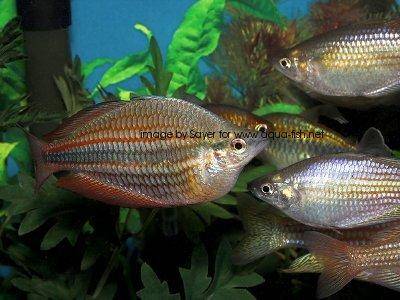

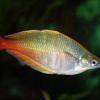 Bleher’s
Bleher’s 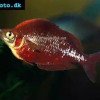 Red
Red 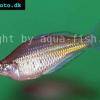 Ramu
Ramu 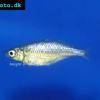 Wanam
Wanam 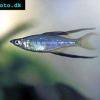 Threadfin
Threadfin 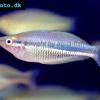 New
New 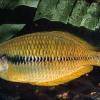 Yakati
Yakati  Boesemani
Boesemani 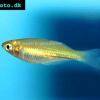 Crimson
Crimson 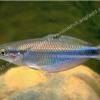 Goldie
Goldie 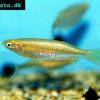 Slender
Slender 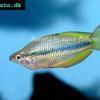 Lake
Lake 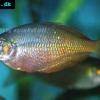 Irian
Irian 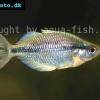 Kamaka
Kamaka 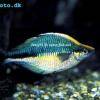 Lake
Lake 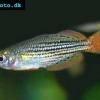 Dwarf
Dwarf 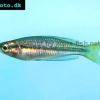 Black
Black 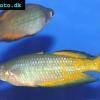 Parkinsoni
Parkinsoni 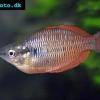 Sunset
Sunset 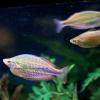 Neon
Neon 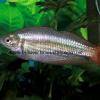 Western
Western 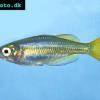 Inornate
Inornate 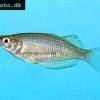 Ruby
Ruby 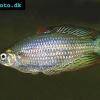 Eastern
Eastern 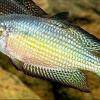 Desert
Desert 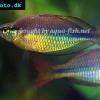 Regal
Regal